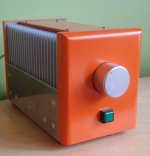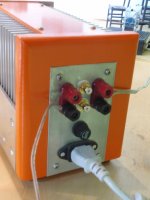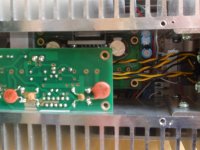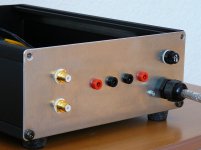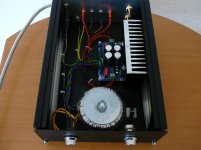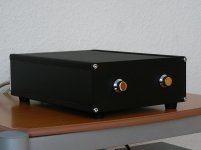I love the heatsinks...
dave
They work very well.
I wish I could find more.
I love the heatsinks...
Me too. I would even have put them on top of the case to show them off.
Here's my LM3886 based amp. Acquired the heatsink from local supplier, and the PCB came pre-assembled overseas (from China I think).
The PSU is a DIY SMPS, taking 12V inputs with 20V CT DC-outputs. This is because the SMPS produces no audible hum on the speakers. The amp just seems dead without any signal ;-) A little underpowered because I don't have the time to rewound the EL transformer 😀
Placed the whole lot on my study desk 😛
Here are the attachments, as the previous links might have broken.
I like the thick power wires going from your power supply to the amp modules.
I see so many amps in this thread that have nice thick wires from the amp to the speakers, yet have tiny strands going between the amp and the power supply module.
Makes no sense at all.
you have not considered the filter effects that can be gained by selecting appropriate resistances and inductances in the route from transformer to speaker.I see so many amps in this thread that have nice thick wires from the amp to the speakers, yet have tiny strands going between the amp and the power supply module.
Makes no sense at all.
No i have not, i have always relied on the psu to safely filter out any noise, and make sure the amp modules can use the full voltage of the power supply without sagging due to resistances in the PSU lines.
It seems to be counter intuitive to have resistance in the power supply lines that limits the max current that can flow, but then use thick speaker cable to make sure that current is NOT limited.
I would think sag in the power rails would be avoided, isnt that why regulated power supplies exist?
It seems to be counter intuitive to have resistance in the power supply lines that limits the max current that can flow, but then use thick speaker cable to make sure that current is NOT limited.
I would think sag in the power rails would be avoided, isnt that why regulated power supplies exist?
I see so many amps in this thread that have nice thick wires from the amp to the speakers, yet have tiny strands going between the amp and the power supply module.
The opposite of what makes sense.
dave
Capacitance alone cannot work as a filter.
It needs rC or LC to create the filter.
The secondary winding and the wiring from transformer to rectifier to smoothing bank provide both resistance and inductance (as well as capacitance) and then the smoothing capacitance can operate as a filter.
The wiring from the smoothing capacitance to the amplifier and the rail trace impedances act with the decoupling capacitance to create a second line of filtering.
0milli-Ohm and 0milli-Henry with C is not a filter.
1mOhm and 0.01mHenry with C is an effective filter.
2m-Ohm and 0.02mHenry is a more effective low pass filter.
20Apk to the speaker and 0r002 is a voltage drop of 40mVpk between the smoothing and the decoupling.
This can never be zero mVpk, no matter how big you make your cords/cables/plates!!!
Now tell us you don't use filtering.
You use it all the time, but did not realise that what you originally said is complete balderdash.
It needs rC or LC to create the filter.
The secondary winding and the wiring from transformer to rectifier to smoothing bank provide both resistance and inductance (as well as capacitance) and then the smoothing capacitance can operate as a filter.
The wiring from the smoothing capacitance to the amplifier and the rail trace impedances act with the decoupling capacitance to create a second line of filtering.
0milli-Ohm and 0milli-Henry with C is not a filter.
1mOhm and 0.01mHenry with C is an effective filter.
2m-Ohm and 0.02mHenry is a more effective low pass filter.
20Apk to the speaker and 0r002 is a voltage drop of 40mVpk between the smoothing and the decoupling.
This can never be zero mVpk, no matter how big you make your cords/cables/plates!!!
Now tell us you don't use filtering.
You use it all the time, but did not realise that what you originally said is complete balderdash.
Last edited:
PCB filter banks provide short term transits with local reserves and music is not continuous.
If you like them heatsinks, why not try looking for Rc nitro car heatsinks? Surely they will so the same job? Well they are meant for cooling engines. this is DIY after all. Below is an example, but many different types available.
Team Associated Monster GT Aluminum Engine Heat Sink - 12 Fins (For Pro 21R) Silver GPM Racing AGM2815
Team Associated Monster GT Aluminum Engine Heat Sink - 12 Fins (For Pro 21R) Silver GPM Racing AGM2815
Here is my first SS build. I wanted to see how compact and simple I could get away with. This uses a Lambda switching power supply (in the bottom half) to drive a pair of LM3875s bolted to the large heat sinks in the top half. The circuit probably took me 3 hours to complete, but I fiddled with the enclosure for the better part of 4 months. Final dimensions are 6x5x10 (inches).
Attachments
Be careful with those sinks. I dont know if you isolated them from the amp chip. With LM3886 I know that the metal tab of the amp chip is good to keep isolated. The reason why is that if you somehow touch the chassis or sink with ground you will zap that chip. I dont think the chassis is isolated from the sinks. Definitely keep sinks away from ground.That is exactly what I thought of when I found the two I am using. 😉
Too Bad...
To bad this forum doesn't have a Reputation System. That's andorable work of art you created!
Here is my first SS build. I wanted to see how compact and simple I could get away with. This uses a Lambda switching power supply (in the bottom half) to drive a pair of LM3875s bolted to the large heat sinks in the top half. The circuit probably took me 3 hours to complete, but I fiddled with the enclosure for the better part of 4 months. Final dimensions are 6x5x10 (inches).
To bad this forum doesn't have a Reputation System. That's andorable work of art you created!
LM1875
Hello,
here are some pictures of my LM1875 Amp.
I use Panasonic NHG caps, Wima MKS and a 120VA transformer with 2x 15V.
Regards Olaf
Hello,
here are some pictures of my LM1875 Amp.
I use Panasonic NHG caps, Wima MKS and a 120VA transformer with 2x 15V.
Regards Olaf
Attachments
Last edited:
- Home
- Amplifiers
- Chip Amps
- Chip Amp Photo Gallery
